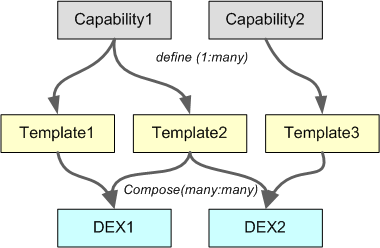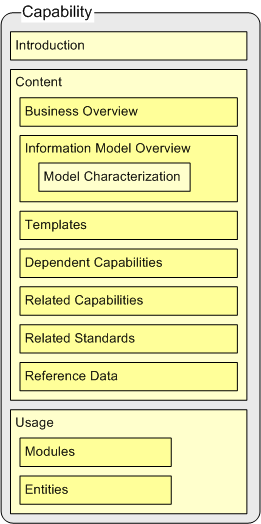 describes the purpose of Capabilities and their
relationship to other PLCS components.
describes the purpose of Capabilities and their
relationship to other PLCS components.
| Help TOC > PLCS technical description > Capabilities | |
| Capabilities | Date: 2008/03/04 16:32:17 Revision: 1.23 |
This technical description of Capabilities describes the purpose of Capabilities and their
relationship to other PLCS components.
describes the purpose of Capabilities and their
relationship to other PLCS components.
Capabilities provide guidance on how the IS0 1030-239 PLCS information model and associated
Templates should be used.
They correspond to the "chapters" of a notional PLCS usage guide within which a set of
Templates are defined, which are then reused by multiple DEXs as shown in Figure 1.
should be used.
They correspond to the "chapters" of a notional PLCS usage guide within which a set of
Templates are defined, which are then reused by multiple DEXs as shown in Figure 1.

 should be used.
As well as general guidance, a set of Templates are defined within a Capability to provide
precise specifications of which Entities should be instantiated to represent
identified concepts.
should be used.
As well as general guidance, a set of Templates are defined within a Capability to provide
precise specifications of which Entities should be instantiated to represent
identified concepts.
Definition:
A Capability is a description of how EXPRESS entities are used to represent a given concept
(a specific "functionality" or "capability").
It provides guidance and rules on what Entities should be used to represent a given
concept,
how the entities should be related, and what Reference Data
entities are used to represent a given concept
(a specific "functionality" or "capability").
It provides guidance and rules on what Entities should be used to represent a given
concept,
how the entities should be related, and what Reference Data should be used.
As well as general guidance, a set of Templates are defined within a Capability to provide
precise specifications of which Entities should be instantiated to represent
identified concepts.
should be used.
As well as general guidance, a set of Templates are defined within a Capability to provide
precise specifications of which Entities should be instantiated to represent
identified concepts.
The concepts represented in the Capabilities are generic business level concepts
(such as a "part" or an "approval") whose meaning is agreed within the
PLCS OASIS community and is common to most applications of PLCS but which are not specific to a particular industrial
domain.
The Capability description is both graphical and textual to facilitate human understanding and
consists of a business overview and a detailed description of the usage of the information model
Reference Data classes .
Each
Capability also defines a set of one or more "Templates"
.
Each
Capability also defines a set of one or more "Templates" .
Each Template provides a precise, computer interpretable specification of which PLCS entities are required
and how they should be populated.
.
Each Template provides a precise, computer interpretable specification of which PLCS entities are required
and how they should be populated.
See the Templates section for further details on Templates.
Examples of Capabilities in PLCS are:
The structure of the Capability is as shown in Figure 2 and comprises:

In summary, Capabilities:
Most Capabilities belong to one of three basic types, with the type often reflected in Capability name. Namely:
Each Capability is identified within the DEXlib repository by a number, an identifier and a name, e.g.
repository by a number, an identifier and a name, e.g.
These are assigned to the Capability in the initial development process.
Each Capability contains:
 Implementation
Module; and
Implementation
Module; and